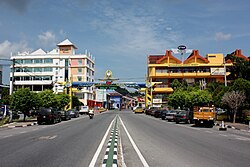Perlis
This article needs additional citations for verification. (June 2008) |
Perlis
ﭬﺮليس | |
|---|---|
| Perlis Indera Kayangan | |
| Anthem: Amin amin ya Rabaljalil | |
 | |
| Capital | Kangar |
| Royal capital | Arau |
| Government | |
| • Ruling party | Barisan Nasional |
| • Raja of Perlis | Tuanku Syed Sirajuddin |
| • Menteri Besar | Datuk Seri Dr Md Isa Sabu |
| Area | |
| • Total | 810 km2 (310 sq mi) |
| Population (2009 est.) | |
| • Total | 241,000 |
| • Density | 300/km2 (770/sq mi) |
| Human Development Index | |
| • HDI (2003) | 0.785 (medium) |
| Postal code | 01xxx |
| Calling code | 04 |
| Vehicle registration | R |
| Website | http://www.perlis.gov.my |
Perlis (Jawi ﭬﺮليس) [1], is the smallest state in Malaysia. It lies at the northern part of the west coast of Peninsular Malaysia and has Satun and Songkhla Provinces of Thailand on its northern border. It is bordered by the state of Kedah to the south. Perlis was called Palit (Thai: ปะลิส) by the Siamese when it was under their influence.
Perlis Indera Kayangan has a population of 210,000. The ethnic composition for the year 2000 in Perlis was: Malay (174,805 or 79.74%), Chinese (21,058 or 9.6%), Indian (2,658 or 1.21%) and others (20,690 or 9.45%).
The capital of Perlis is Kangar and the Royal capital is Arau. Another important town is Padang Besar, at the Malaysian-Thailand border. The main port and ferry terminal is at the small village of Kuala Perlis, linking mostly to Langkawi Island. Perlis has a famous snake farm and research centre at Sungai Batu Pahat and Gua Kelam and Perlis State Park are tourist attractions. Compared to other states of Malaysia, Perlis has bucolic charm, peace and simplicity.
History


Perlis was originally part of Kedah, although it occasionally came under rule by Siam or Aceh. After the Siamese conquered Kedah in 1821, the British felt their interests in Perak to be threatened. This resulted in the 1826 Burney and Low Treaties formalising relations between the two Malay states and Siam, their nominal overlord. In the Burney Treaty, the exiled Kedah sultan Ahmad Tajuddin was not restored to his throne. Sultan Ahmad and his armed supporters then fought unsuccessfully for his restoration over twelve years (1830-1842).
In 1842, the Sultan finally agreed to accept Siamese terms, and was restored to his throne of Kedah. However, Siam separated Perlis into a separate principality directly vassal to Bangkok. Sayyid Hussain Jamalulail, the paternal grandson of a Hadhrami Arab Sayyid[2] immigrant and maternal grandson of the Sultan of Kedah, became the first Raja of Perlis.[3] His descendants still rule Perlis, but as rajas, instead of as sultans.
As with Kedah, the Anglo-Siamese Treaty of 1909 forced Siam to relinquish its southern Malay vassal states to Great Britain. The British installed a Resident in the Perlis Royal capital of Arau. Perlis was returned to Siam by the Japanese in World War II as a reward for Siam's alliance with Japan, but this brief annexation ended with the Japanese surrender. After World War II, Perlis returned to British rule until it became part of the Malayan Union, then Federation of Malaya in 1957 and lastly Federation of Malaysia in 1963.
Since 2000, the Raja or hereditary monarch has been Tuanku Syed Sirajuddin. He was the Yang di-Pertuan Agong of Malaysia from 2001 to 2006. Tuanku Syed Faizuddin Putra was the Regent of Perlis during the five-year period when Tuanku Syed Sirajuddin was Yang di-Pertuan Agong. The Chief Executive or Menteri Besar is Datuk Seri Dr Md Isa Sabu of Barisan Nasional.
The Coat of Arms of Perlis consists of a sturdy green wreath of padi, indicating the wealth of the kingdom and the chief economic activity of the people. The shield in the center represents the pride of the people. Inside the shield is a ring of golden rice surrounding the name "Perlis" written in the Jawi script.
Economy
The state economy is dominated by agriculture, with rice, sugar, herbs and fruits predominating. Forestry especially from Jati timberwoods and fishery is also important, and the state is making great efforts to attract small and medium scale manufacturing industries and services. During the Japanese occupation of Malaya, the Raja of Perlis was Syed Hamzah Jamalullail but the Siamese Government also appointed their own Governor in Perlis by the name of Udom Boonyaprasop. The Japanese lost the War and the British returned as colonialists again and decided to replace Raja Syed Hamzah with Syed Putra Jamalullail who reigned over the smallest State in Malaya and later Malaysia both in terms of size, revenue and population.
Currently, Perlis is planning to develop a land port to ensure Malaysian economy will be able to surpass Singapore's. Despite the fact that the land port is still in planning stage, a local company, Globonus is injecting a huge amount of capital every year to make sure this dream comes true. HAHAHAHAha
Things to do
- Outdoor Rock Climbing at limestone hills Bukit Keteri with over 50 sport climbing routes that bolted by world's climbing team Mammut & Camp5, the crags split into 2 next to each other and the rockfaces rising up about 150m. Range of difficulty from beginner to expert and many variety of climbs available.
See also
References
- ^ The Constitution of Perlis
- ^ http://www.royalark.net/Malaysia/perlis2.htm
- ^ Ulrike Freitag, W. G. Clarence-Smith (1997). Power Hadhrami Traders, Scholars, and Statesmen in the Indian Ocean, 1750s-1960s. BRILL. pp. 85–7. ISBN 9004107711.
External links
- Official Perlis State Government web site
- Web site of His Majesty, the Raja of Perlis
- Perlis caves and tin mines
- Perlis page on the official portal of the ministry of tourism malaysia
- Official Perlis Football Fans
- Outdoor Rock Climbing at Bukit Keteri,Perlis

